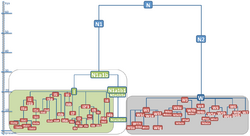Biology:Haplogroup W (mtDNA)
| Haplogroup W | |
|---|---|
| Possible time of origin | 23,900 ybp[1] |
| Possible place of origin | Western Asia |
| Ancestor | N2 |
| Descendants | W1, C194T, W3, W4, W5, W6, W7 |
| Defining mutations | 195 204 207 1243 3505 5460 8251 8994 11947 15884C 16292[2] |
Haplogroup W is a human mitochondrial DNA (mtDNA) haplogroup.
Origin
Haplogroup W is believed to have originated around 23,900 years ago in Western Asia.[1] It is descended from the haplogroup N2.
Distribution
Haplogroup W is found in Europe, Western Asia, and South Asia.[3] It is widely distributed at low frequencies, with a high concentration in Northern Pakistan .[4] Haplogroup W is also found in the Maghreb among Algerians (1.08%-3.23%)[5] and in Siberia among Yakuts (6/423 = 1.42%[6]).
Additionally, the clade has been observed among ancient Egyptian mummies excavated at the Abusir el-Meleq archaeological site in Middle Egypt, which date from the Ptolemaic Kingdom.[7]
The W5 subclade has been found in a fossil associated with the Starčevo culture (Lánycsók site; 1/1 or 100%).[8]
Ancient DNA analysis found that the medieval individual Sungir 6 (730-850 cal BP) belonged to the W3a1 subclade.[9]
Subclades
Tree

This phylogenetic tree of haplogroup W subclades is based on the paper by Mannis van Oven and Manfred Kayser Updated comprehensive phylogenetic tree of global human mitochondrial DNA variation[2] and subsequent published research.
- W
- W1
- W1a
- W1b
- W1b1
- W1-T119C
- W1c
- W1c1
- W1c
- W1d
- W1e
- W1e1
- W1e1a
- W1e1
- W1f
- W1g
- W1h
- W1h1
- W-C194T
- W3
- W3a
- W3a1
- W3a1a
- W3a1a1
- W3a1a2
- W3a1a3
- W3a1b
- W3a1-T199C
- W3a1c
- W3a1d
- W3a1a
- W3a2
- W3a1
- W3b
- W3b1
- W3a
- W4
- W4a
- W4a1
- W4b
- W4c
- W4d
- W4a
- W5
- W5a
- W5a1
- W5a1a
- W5a1a1
- W5a1a1a
- W5a1a1
- W5a1a
- W5a2
- W5a2b
- W5a1
- W5b
- W5b1
- W5b1a
- W5b1
- W5a
- W6
- W6a
- W6b
- W6c
- W7
- W8
- W9
- W3
- W1
See also
|
Phylogenetic tree of human mitochondrial DNA (mtDNA) haplogroups | |||||||||||||||||||||||||||||||||||||||
| Mitochondrial Eve (L) | |||||||||||||||||||||||||||||||||||||||
| L0 | L1–6 | ||||||||||||||||||||||||||||||||||||||
| L1 | L2 | L3 | L4 | L5 | L6 | ||||||||||||||||||||||||||||||||||
| M | N | ||||||||||||||||||||||||||||||||||||||
| CZ | D | E | G | Q | O | A | S | R | I | W | X | Y | |||||||||||||||||||||||||||
| C | Z | B | F | R0 | pre-JT | P | U | ||||||||||||||||||||||||||||||||
| HV | JT | K | |||||||||||||||||||||||||||||||||||||
| H | V | J | T | ||||||||||||||||||||||||||||||||||||
References
- ↑ 1.0 1.1 Soares, Pedro; Luca Ermini; Noel Thomson; Maru Mormina; Teresa Rito; Arne Röhl; Antonio Salas; Stephen Oppenheimer et al. (4 Jun 2009). "Supplemental Data Correcting for Purifying Selection: An Improved Human Mitochondrial Molecular Clock". The American Journal of Human Genetics 84 (6): 82–93. doi:10.1016/j.ajhg.2009.05.001. PMID 19500773.
- ↑ 2.0 2.1 van Oven, Mannis; Manfred Kayser (13 Oct 2008). "Updated comprehensive phylogenetic tree of global human mitochondrial DNA variation". Human Mutation 30 (2): E386–E394. doi:10.1002/humu.20921. PMID 18853457.
- ↑ Petraglia, Michael D.; Allchin, Bridget (2007). The Evolution and History of Human Populations in South Asia: Inter-disciplinary Studies in Archaeology, Biological Anthropology, Linguistics and Genetics. Springer Science & Business Media. p. 237. ISBN 978-1-4020-5562-1. https://books.google.com/books?id=Qm9GfjNlnRwC&pg=PA237.
- ↑ Meit Metspalu et al., Most of the extant mtDNA boundaries in South and Southwest Asia were likely shaped during the initial settlement of Eurasia by anatomically modern humans. BMC Genetics, 2004
- ↑ Asmahan Bekada; Lara R. Arauna; Tahria Deba; Francesc Calafell; Soraya Benhamamouch; David Comas (September 24, 2015). "Genetic Heterogeneity in Algerian Human Populations". PLOS ONE 10 (9): e0138453. doi:10.1371/journal.pone.0138453. PMID 26402429. Bibcode: 2015PLoSO..1038453B.; S5 Table
- ↑ Sardana A Fedorova, Maere Reidla, Ene Metspalu, et al., "Autosomal and uniparental portraits of the native populations of Sakha (Yakutia): implications for the peopling of Northeast Eurasia." BMC Evolutionary Biology 2013, 13:127. http://www.biomedcentral.com/1471-2148/13/127
- ↑ Schuenemann, Verena J. (2017). "Ancient Egyptian mummy genomes suggest an increase of Sub-Saharan African ancestry in post-Roman periods". Nature Communications 8: 15694. doi:10.1038/ncomms15694. PMID 28556824. Bibcode: 2017NatCo...815694S.
- ↑ Mark Lipson (2017). "Parallel palaeogenomic transects reveal complex genetic history of early European farmers". Nature 551 (7680): 368–372. doi:10.1038/nature24476. PMID 29144465. PMC 5973800. Bibcode: 2017Natur.551..368L. http://docdro.id/kHZiI2t. Retrieved 18 November 2017.
- ↑ Sikora, Martin; Seguin-Orlando, Andaine; Sousa, Vitor C.; Albrechtsen, Anders; Korneliussen, Thorfinn; Ko, Amy; Rasmussen, Simon; Dupanloup, Isabelle et al. (2017). "Ancient genomes show social and reproductive behavior of early Upper Paleolithic foragers". Science 358 (6363): 659–662. doi:10.1126/science.aao1807. ISSN 0036-8075. PMID 28982795. Bibcode: 2017Sci...358..659S.
External links
- General
- Mannis van Oven's Phylotree
- The India Genealogical DNA Project
- Haplogroup W
- Spread of Haplogroup W, from National Geographic
- mtDNA Haplogroup W Project


